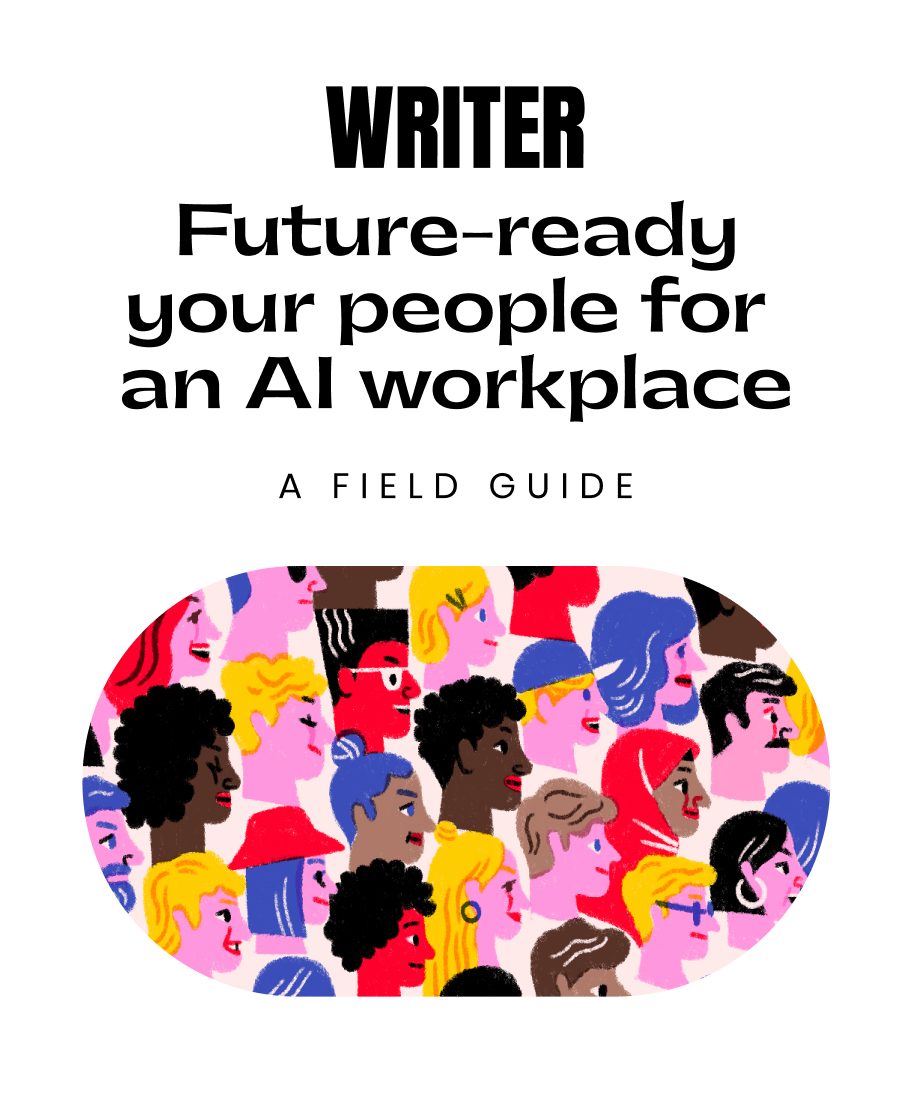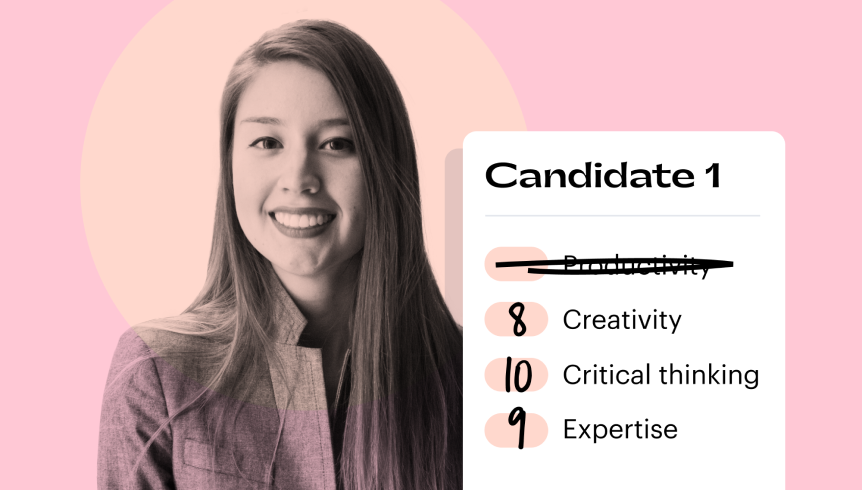Future-ready your people for an AI workplace

Let’s do a little time travel. Go on: hop into your DeLorean/TARDIS/phone booth/hot tub/Wayback Machine — whatever your time machine of choice is — and set the dial to your workplace, circa 2030. Most people at your company are using generative AI as part of their jobs. They’re relying on AI solutions for creating content and reports, finding answers to questions among your company’s labyrinth of internal docs, and driving consistency and compliance.
Yet, amid the pulse of progress, some pertinent questions arise:
Is this workplace of the future emptier than that of today due to leadership replacing people with AI?
Are the people at your company using their creative and critical thinking skills more, or are they glorified AI operators?
What’s the future you want to see?

Download the ebook
The essence of leadership isn’t just about embracing innovation. It’s about ensuring that the soul of the organization – its people – remains vibrant and valued. The actions you take today as you inform your company’s AI principles and culture, hire and train employees, and choose your AI technology partners will shape the future you’re seeing. And it will determine the soul of tomorrow’s workplace.
As a leader, your mission is to sculpt a tomorrow where AI serves as a potent ally, enhancing the intrinsic capabilities of every individual, rather than usurping their roles.
In this guide, we’ll show you how to nurture a “people-first” culture and future-ready your workforce in an AI-infused world, ensuring both competitiveness and compassion coexist.
- A people-first workplace: prioritizes employee well-being, promotes diversity and inclusion, keeps lines of communication open and creates an environment that encourages collaboration and creativity.
- To maintain a people-first approach amid AI transformation: adapt existing hiring practices for an AI workplace. Support existing employees in the face of AI disruption. Craft a corporate AI policy. Develop a generative AI adoption roadmap. Hire an AI program director.
What makes a workplace people-first?
A people-first workplace puts the personal and professional growth of its employees at the center of its strategy, particularly in an environment increasingly dominated by technology. This goes beyond providing staff with comfortable chairs and free coffee. In an AI-infused workplace, being people-first means:
1. Prioritizing employee well-being
A people-centric company cares deeply about the wellbeing of its team. Wildbit lays it down perfectly in their “4 Rs of people-first culture” by pointing out that people prefer working for companies that care for their employees. They also want companies that invest in their team and support and empower team members to succeed.
With the challenges posed by factors like the rise of AI, economic difficulties, and massive layoffs, more than ever, companies need to have their employees’ backs. One way to do this is by investing in continuous learning and development programs that focus on upskilling. As AI reshapes the workspace, offering up-to-date training allows employees to adapt and grow with these changes. This can help reduce stress and job insecurity. Investing in your employees’ career growth and well-being is a surefire way to make them feel more comfortable and engaged in a workplace that’s increasingly reliant on AI.
2. Promoting diversity and inclusion
A diverse workforce is not just an HR checkbox but a vital factor in a company’s success. Diverse teams bring varied perspectives that can provide unique solutions to complex problems. In fact, diverse and inclusive workplaces are more innovative and better at problem-solving.
When it comes to AI, inclusion means ensuring that different viewpoints are considered, leading to more robust AI systems. That’s because, at its core, AI is about data interpretation and decision-making. When only a singular perspective informs AI development, the resulting systems may have inherent biases that can lead to incorrect decisions and outcomes. However, having multiple viewpoints can mitigate potential AI bias issues and instill more objectivity and fairness in AI systems.
3. Keeping lines of communication open
Effective communication is essential in any workplace, especially in settings undergoing technological changes.
Open dialogue between management and staff ensures everyone is on the same page about the company’s AI direction. It provides a platform for employees to voice their concerns, ask questions, and offer suggestions. Remember, employees on the front lines often have firsthand insights that can be invaluable in guiding the effective use of technology. Clear and consistent communication can also help alleviate any feelings of anxiety and apprehension and foster a sense of trust and transparency.
Furthermore, encouraging open communication paves the way for cross-functional collaboration. When departments share their experiences and learnings, they can collectively develop best practices, streamline processes, and ensure the successful adoption and integration of AI.
4. Creating an environment that encourages collaboration and creativity
AI should serve as a tool that enhances, rather than replaces, human capabilities. An ideal people-first workplace would use AI to automate routine tasks, leaving the challenging, innovative aspects to the human mind. This shift allows employees to focus on what they do best: thinking outside the box, connecting seemingly unrelated dots, and collaborating in fresh and exciting ways. Therefore, it’s important to create an environment that encourages collaboration and celebrates human creativity.
For instance, in a people-first content production team, AI could be tasked with drafting initial article content. Human editors can then step in to refine the piece, adding a personal touch with narrative flair and contextual nuances. Ultimately, marrying efficiency with creativity and personalization. This collaborative approach allows for high-quality, engaging content that leverages the strengths of both AI and human creativity.
Discover how three teams are improving collaboration with AI:
How to maintain a people-first approach amid AI transformation
To develop and cultivate a people-first workplace that prioritizes employee well-being, is inclusive and diverse, and fosters open communication, collaboration, and creativity, it’s essential to integrate these values into every aspect of your AI transformation journey. Here’s how:
1. Adapt your hiring practices for an AI workplace
Only 18% of organizations from Deloitte’s 2023 Global Human Capital Trends survey believe their leaders are equipped for the tech-driven challenges ahead.
If you want your organization to thrive in a landscape increasingly dictated by algorithms, data sets, and machine learning, you’ll need to create an AI-ready workforce by:
- Shifting the “entry-level” mindset
The face of entry-level roles is changing, with AI taking over many tasks. So, it’s time to look at apprenticeships. These programs groom talent for our tech-driven future, ensuring continuous learning and growth. - Championing human expertise
AI’s fantastic, but it doesn’t hold a candle to human experience and insight. We’ll always need sharp minds to oversee and refine AI’s work. This is especially true when precision is paramount, like in regulated industries. - Empowering employees with AI tools
AI can automate 50% of daily tasks. By integrating AI tools, employees can focus on high-impact tasks. Consider hiring a program director to oversee the introduction of AI training and tools.

Want to learn more about adapting your hiring practices for an
AI-centric hiring world?
Dive deeper in our future of talent article.
2. Support existing employees in the face of AI disruption
You can embrace technological change while being mindful of its impact on existing employees. Take it as an opportunity to evolve rather than replace, and put strategies in place to help employees be successful by:
- Clearly communicating your stance on AI
As we mentioned earlier, effective communication is a hallmark of an employee-first workplace. Share your AI vision with your team. What’s the plan? How does AI impact the business? Your customers too, should understand your plans for using AI. Make sure that all AI technologies and vendors used are transparent about the data used to train its models, too. - Spark AI exploration
Enabling and motivating employees to explore generative AI use cases can be a great way to discover high-value outcomes. To do so, set up guardrails and expectations to ensure the journey is successful. - Invest in learning
The future has a place for human intelligence powered by AI assistance. Prep your team for this through online courses, apprenticeships, and boot camps.

For more in-depth insights and strategies, check out our article on supporting your existing employees in the face of AI disruption.
3. Craft a corporate AI policy
Your company’s AI policy is more than just guidelines for ethical and responsible use of AI technologies. It’s a statement of your commitment to putting employees first when deploying AI. Want to craft a policy that genuinely resonates with a people-first mindset? Here are a few steps:
- Tune into your goals
Before diving into AI, understand what your organization hopes to achieve. This step allows you to identify where AI can add value and how it can complement, rather than replace, human roles. - Create a governance framework
To ensure that AI is used ethically, transparently, and responsibly. Critical to this is a set of guiding questions that prioritize employee welfare, ethical considerations, and clear accountability. This ensures that AI adoption aligns with your company’s commitment to its people. - Educate employees
Knowledge is power. Thus, educating employees about your AI policy is central to fostering responsible and ethical AI use. Interactive sessions, case studies, and multimedia content make training engaging and informative. Employees can ask questions and clarify doubts. This promotes an environment of openness and mutual respect. - Monitor AI performance
To make sure AI works as intended and matches your goals, you should monitor it regularly. Tracking metrics such as accuracy, and system fairness prevents biases in output and respects diverse perspectives. - Institute regular reviews and updates
The AI world is ever-changing. Therefore, you should regularly revisit and refresh your policy, with employee input and new regulations in mind. This ensures it stays timely and relevant and reflects the best interests of the people it affects.

Every company needs an AI approach that’s grounded, ethical, and people-centric. Is yours on track?
Read our guide: Every company needs a corporate AI policy.
4. Develop a generative AI adoption roadmap
Your journey to successful AI adoption is only as smooth as the path you pave for it. That’s why having a generative AI adoption roadmap is paramount. It serves as a strategic guide for weaving AI into your organization in a manner that uplifts, empowers, and respects every stakeholder. Here’s how to do it:
- Adopt a phased approach
To prepare your teams for an AI workplace, follow a crawl/walk/run approach. Start with a low-risk, proof-of-concept use case. Followed by piloting various tools, and gathering feedback and ideas from power users. Then finally roll out training and implementation team by team. This approach allows you to build a successful AI workplace in an agile and lower-risk manner. - Create a safe space for AI exploration
This allows employees to hone their skills and receive feedback so they can better understand how to use AI. - Empower your creative minds with AI
While AI can lighten your employees’ workload, the people using it should have more expertise and creativity than the tools. Users need to know how to identify top-notch results, verify facts, and use it for enhanced work. - Use AI tools where your team already works
To ensure a successful transition to an AI workplace, select AI tools that integrate seamlessly with existing software. This approach ensures both smooth adoption and employee comfort with new technologies. - Create AI prompt virtuosos
Instead of using generic online suggestions, train your team to create effective natural language prompts for AI. Additionally, they’ll discern when it’s more appropriate to use a template over a prompt.

Ready to pave your organization’s path to AI mastery?
Discover more in our
Generative AI adoption roadmap
5. Hire an AI program director
Alright, deep breath! We’re about to deep dive into the last, but crucial leg of the AI integration journey —choosing a leader who can champion this transition with empathy and insight. An AI program director is key to creating an AI future-ready workplace. They need to have a balance of technical expertise and a profound understanding of human-centric principles. Here is how this role can be a cornerstone in your AI adoption journey:
- Implement AI in a way that serves your business goals
An AI program director strategizes how to best utilize AI within a company by analyzing its specific needs and challenges. Different parts of the organization have different needs, so the AI program director will help tailor the AI solution to each team. - Find the right AI tools
With so many AI products on the market, it’s vital to select tools that are effective and secure. The director’s job is to make sure these tools yield maximum benefits and align with the unique demands of the business. - Measure and report on the impact of AI initiatives
This process ensures that AI adoption yields a positive return on investment. Additionally, the director can pinpoint areas of improvement, potentially necessitating further training or workflow adjustments. - Ensure ethical and compliant use of AI
In preparing the workforce for an AI-centric workplace, an AI program director is instrumental in foreseeing and countering the risks posed by generative AI. They play a key role in crafting AI ethics guidelines, ensuring that AI usage aligns with the company’s values and industry standards. - Make sure your workforce can successfully use AI
One of the biggest responsibilities the AI program director has is to “own generative AI literacy within the company.” This includes identifying and supporting top performers and early adopters, training employees, and making sure the workforce adapts to the needs of AI work.



